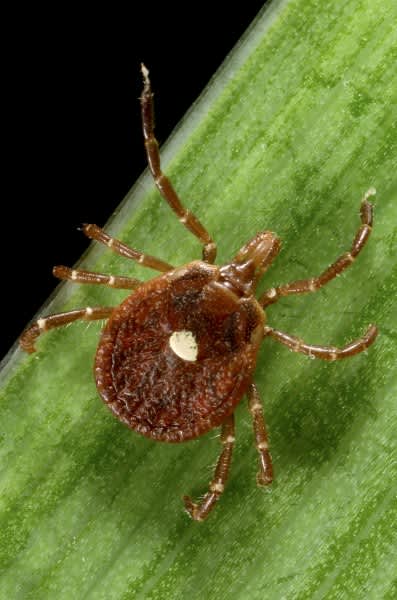Ticks: Being Proactive for Your Own Health
The Professor's Blog 08.13.13

Recently, I saw a report that scientists demonstrated that ticks have transmitted Heartland virus in the United States. The report supports what I have thought for a while–that we are just scratching the surface of what we know about ticks and the bacteria and viruses they spread.
Ticks are in the class Arachnida and are relatives of spiders. They eat blood from their host and can pass infections from one host to the next, including humans. Some common tick diseases include Lyme disease, babesiosis, ehrlichiosis, Rocky Mountain spotted fever, and human granulocytic anaplasmosis.
Lyme disease
Spread by the black-legged or deer tick, this disease is common in the Northeast. Lyme disease is an infection caused by a type of bacteria transmitted by ticks to humans. Lyme disease mimics many other diseases and can affect any organ of the body, including the brain and nervous system, muscles and joints, and the heart. Symptoms include a circular rash at the site of the tick bite, tiredness, and neurological and facial muscular problems. There are different schools of thought on the treatment of Lyme disease, however the common view is to treat with the antibiotic doxycycline.
Babesiosis
An infection caused by a malaria-like protozoan parasite. Babesia microti is believed to be the most common protozoan parasites (piroplasm) infecting humans, but scientists have identified over 20 piroplasms carried by ticks. Symptoms of babesiosis are similar to those of Lyme disease but starts with a high fever and chills transitioning to fatigue, headache, drenching sweats, muscle aches, nausea, and vomiting. Babesiosis is treated with a combination of two types of anti-parasite drugs, atovaquone (Mepron, Malarone) plus an erythromycin-type drug (azithromycin, clarithromycin, or telithromycin). Long-standing infections may need to be treated for several months, and relapses sometimes occur and must be retreated.
Ehrlichiosis
Spread by the lone star tick and carried by dogs, cattle, sheep, goats, and horses. Ehrlichiosis was originally thought to be only an animal disease but was described in humans in 1987. The disease is now found in 30 states, predominately in the Southeast, South Central, and the Mid-Atlantic states, as well as Europe and Africa. Studies suggest that in endemic areas as much as 15 to 36 percent of the population has been infected. Symptoms include high fever, fatigue, muscle aches, and headache. The disease can be mild or life-threatening and deaths have occurred. The treatment of choice is antibiotics including doxycycline, with rifampin recommended in case of primary treatment failure.
Rocky Mountain spotted fever
Caused by bacteria called Rickettsia rickettsii that are transmitted by the bite of a tick. Common to the Southeast, symptoms include sudden onset of fever, headache, and muscle pain, followed by development of rash. The disease can be difficult to diagnose in the early stages, and without prompt and appropriate treatment it can be fatal. It is treatable with antibiotics, often doxycycline.
So what can we do to protect ourselves? The best defense is to take steps to protect yourself from tick bites when in the woods or areas where ticks are known to live:
- Wear light-colored clothing and long pants tucked into boots or socks.
- Use insect repellents containing 20 to 30 percent DEET on your exposed skin and clothing to prevent tick bites.
- Use Permanone or Permethrin for on your clothes and not on your skin.
- Check your skin and clothes for ticks every day.
- Shower after working outdoors and check for ticks (all over!).
If you do find a tick:
- Immediately remove ticks using fine-tipped tweezers.
- Grasp the tick firmly as close to your skin as possible and pull away from you with a steady motion.
- Clean the area with soap and water.
- Wash and dry work clothes in a hot dryer to kill any ticks present.
If you spend time outdoors,
- YOU MUST learn about tick-borne diseases.
- YOU MUST understand the symptoms.
- YOU MUST take responsibility for your own health.
If you begin to feel poorly and have symptoms that match what was described above, seek medical attention promptly. YOU MUST tell your health care provider that you have been outside and that you would like to be tested for tick-borne diseases. Remember, they may not know what you do or where you have been!
A case in point: every spring, I teach an extended outdoors course and spend a lot of time in areas where ticks thrive. This year, the ticks were especially numerous. A few weeks after the course ended, I began to feel tired, achy, and run down. I went to the doctor, explained my symptoms, and requested to be tested for all tick-borne diseases. I was diagnosed with Rocky Mountain spotted fever and just ended the doxycycline antibiotic treatment. Although I am not sure the diagnoses is absolutely correct, I will continue to learn about tick diseases and monitor my health. As stated above, we are just scratching the surface of what we know about ticks and the bacteria and viruses they spread.
If you enjoyed this article, I hope you will continue to follow me on OutdoorHub. Additionally, please follow me on Skinny Moose, where I post a variety of different blogs.

